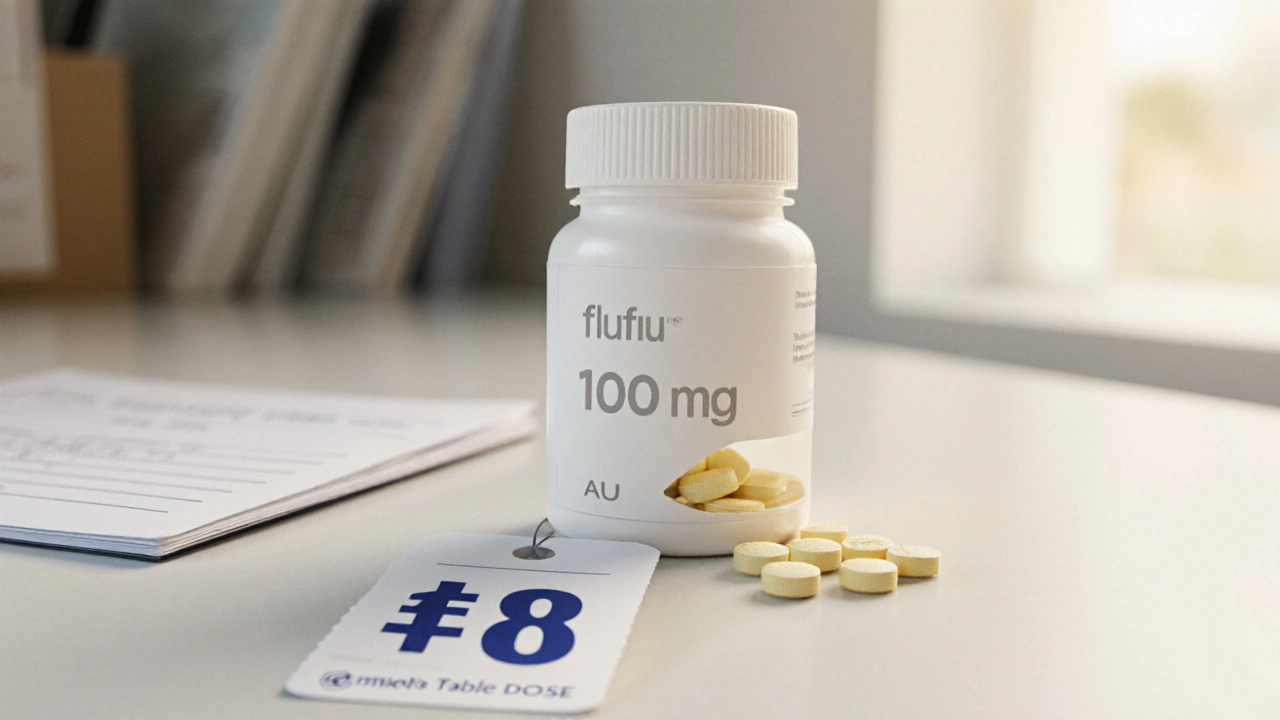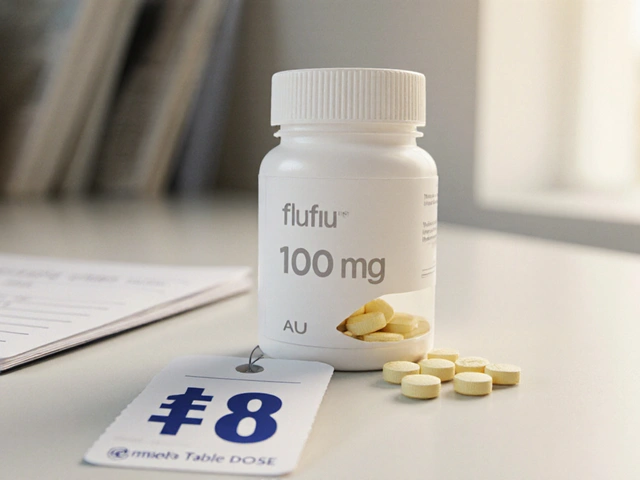When a doctor prescribes an antifungal, many patients wonder whether there’s a cheaper, safer, or more effective option than the brand‑name drug they’ve heard about. Diflucan is the trade name for fluconazole, an oral antifungal used for a wide range of yeast and mild mold infections. This article breaks down how fluconazole stacks up against the most common alternatives, so you can decide which medication matches your condition, budget, and tolerance for side effects.
Key Takeaways
- Fluconazole works best for candidiasis and mild systemic infections, with a simple once‑daily dose.
- Itraconazole and voriconazole cover a broader spectrum but require food‑based dosing and have higher interaction risk.
- Cost varies dramatically: generic fluconazole is often under $10 for a 14‑day course, while newer azoles can exceed $200.
- Kidney and liver function, as well as concurrent medications, should guide the choice of antifungal.
- Most alternatives share similar side‑effect profiles-nausea, headache, and rash-but some (e.g., ketoconazole) carry a higher risk of liver toxicity.
What Is Diflucan (Fluconazole)?
Fluconazole belongs to the triazole class of antifungals. It works by inhibiting the fungal enzyme lanosterol 14‑α‑demethylase, which disrupts the synthesis of ergosterol-a critical component of fungal cell membranes. Because it targets a pathway not found in human cells, fluconazole tends to be well‑tolerated.
Key attributes of fluconazole:
- Spectrum: Effective against most Candida species, Cryptococcus neoformans, and some dimorphic fungi (e.g., Histoplasma capsulatum).
- Typical dosage: 100mg-400mg once daily for most infections; a single 150mg dose for vaginal candidiasis.
- Cost: Generic tablets range from AU$5-10 for a two‑week supply in Australia.
- Side effects: Generally mild-headache, abdominal discomfort, and occasional skin rash.
- Drug interactions: Moderate; inhibits CYP2C9 and CYP3A4, so caution with warfarin, oral contraceptives, and certain statins.
Common Alternatives to Fluconazole
Below are the most frequently used oral antifungals that clinicians consider when fluconazole isn’t ideal.
- Itraconazole - A broader‑spectrum azole that covers many molds but requires an acidic environment for absorption.
- Voriconazole - The go‑to for invasive aspergillosis; offers excellent bioavailability but can cause visual disturbances.
- Posaconazole - Used for prophylaxis in immunocompromised patients; available as delayed‑release tablets and oral suspension.
- Ketoconazole - An older azole with strong hepatic metabolism; now limited to topical use in many countries because of liver risk.
- Terbinafine - A allylamine that works well for dermatophyte infections (e.g., athlete’s foot) but has limited activity against Candida.
- Griseofulvin - Primarily for superficial fungal infections like tinea capitis; requires long treatment courses.

Side‑by‑Side Comparison
| Drug | Spectrum | Typical Indications | Standard Dose | Average Cost (AU$) | Key Side Effects | Major Interactions |
|---|---|---|---|---|---|---|
| Fluconazole | Candida spp., Cryptococcus, limited molds | Vaginal yeast, esophageal candidiasis, cryptococcal meningitis | 100‑400mg daily | 5‑10 (14‑day course) | Headache, GI upset, rash | Warfarin, oral contraceptives, statins |
| Itraconazole | Broad Candida, Histoplasma, Blastomyces, Aspergillus | Blastomycosis, histoplasmosis, chronic pulmonary aspergillosis | 200‑400mg daily (with food) | 15‑30 | Hepatotoxicity, nausea, edema | CYP3A4 substrates, rifampin, macrolides |
| Voriconazole | Wide mold coverage, including Aspergillus | Invasive aspergillosis, candidemia (when fluconazole fails) | 200‑400mg twice daily | 120‑250 | Visual disturbances, photosensitivity, hepatotoxicity | Rifampin, carbamazepine, ergot alkaloids |
| Posaconazole | Broad mold and yeast, excellent for prophylaxis | Prophylaxis in neutropenia, mucormycosis | 300mg once daily (delayed release) | 200‑350 | Diarrhea, QT prolongation, hepatotoxicity | Antacids, H2 blockers, CYP3A4 inducers |
| Ketoconazole | Limited Candida, dermatophytes | Topical fungal infections (oral use limited) | 200‑400mg twice daily | 5‑12 (if still prescribed) | Severe liver injury, adrenal suppression | Many CYP3A4 substrates, hormonal therapies |
| Terbinafine | Dermatophytes, limited Candida | Onychomycosis, tinea pedis | 250mg daily | 20‑40 | Taste alteration, liver enzyme elevation | Rifampin, carbamazepine, cimetidine |
| Griseofulvin | Dermatophytes, some molds | Tinea capitis, tinea corporis | 500‑1000mg daily (divided) | 15‑25 | Headache, GI upset, photosensitivity | Warfarin, oral contraceptives, barbiturates |
How to Choose the Right Antifungal
Picking an antifungal isn’t just about price. Consider these decision points:
- Infection type: Yeast infections (Candida) usually respond to fluconazole; mold‑dominant diseases need a broader azole like voriconazole.
- Organ function: Liver or kidney impairment may limit drugs that are heavily metabolised (e.g., itraconazole).
- Drug‑interaction profile: If you’re on warfarin, steroids, or antiretrovirals, fluconazole’s moderate CYP inhibition is preferable to the strong inhibition of voriconazole.
- Cost and insurance coverage: Generic fluconazole is often fully covered under Australian PBS; newer agents may need prior authorisation.
- Adherence factors: Once‑daily dosing (fluconazole, terbinafine) improves compliance compared with twice‑daily regimens.
Practical Tips for Patients Starting an Antifungal
- Take fluconazole with or without food; other azoles (itraconazole, posaconazole) need a full stomach or an acidic drink to maximise absorption.
- Check liver enzymes before and during therapy if you’re on a drug with known hepatotoxicity (e.g., ketoconazole, voriconazole).
- Tell your pharmacist about all prescription and over‑the‑counter meds-many antifungals affect hormonal contraceptives.
- Complete the full course, even if symptoms improve. Stopping early can lead to recurrence or resistance.
- Store tablets in a cool, dry place; avoid moisture that can degrade the active ingredient.
Frequently Asked Questions
Can I switch from fluconazole to another antifungal without a doctor’s order?
Never. Antifungal choice depends on the exact pathogen, infection site, and your health status. Changing drugs without professional guidance risks treatment failure or serious side effects.
Why is fluconazole cheaper than voriconazole?
Fluconazole has been off‑patent for decades, so many generic manufacturers compete on price. Voriconazole is newer, protected by patents longer, and requires more complex manufacturing, driving up cost.
Are there any foods I should avoid while taking fluconazole?
Fluconazole is not heavily affected by food, but grapefruit juice can increase blood levels of many azoles. It’s safest to limit grapefruit while on any triazole.
What monitoring is needed for liver function?
Baseline liver enzymes (ALT, AST, bilirubin) are recommended before starting any azole with known hepatic metabolism. Repeat testing is advised after 2-4 weeks, especially for itraconazole, voriconazole, or ketoconazole.
Can fluconazole be used during pregnancy?
Fluconazole is generally considered low risk in a single low dose for vaginal candidiasis. High‑dose or prolonged therapy during the first trimester is discouraged due to limited safety data.
Whether you’re treating a simple yeast infection or a more serious systemic mycosis, understanding how fluconazole compares with its peers helps you and your clinician pick the safest, most cost‑effective option. Keep these tables and tips handy, and always discuss any concerns with a qualified pharmacist or doctor before making changes.



Troy Brandt
October 14, 2025 AT 13:14When you look at the big picture of antifungal therapy, the first thing that stands out is how fluorozone (Diflucan) manages to keep a solid balance between efficacy, safety, and price, which is a rare trio in modern pharmacology. The drug's mechanism of action-targeting lanosterol 14‑α‑demethylase-means it spares human cells while hitting the fungal cell membrane where it counts. Because of this selective toxicity, most patients tolerate it without the intense monitoring that more hepatotoxic agents demand. Its once‑daily dosing schedule also plays a pivotal role in adherence, especially for outpatient regimens that stretch over weeks. When you compare that to itraconazole, you have to factor in the requirement for an acidic environment, which can be a hurdle for patients on proton‑pump inhibitors. Voriconazole, while a powerhouse against molds, brings visual disturbances and photosensitivity that can be hard to overlook in a quality‑of‑life assessment. Cost is another critical axis; generic fluconazole often falls under ten dollars for a two‑week course, whereas voriconazole can cost a small fortune, sometimes exceeding two hundred dollars for the same duration. The economics become especially stark when you consider insurance formularies and out‑of‑pocket caps. Moreover, drug‑drug interactions with fluconazole are moderate-mainly CYP2C9 and CYP3A4 inhibition-so clinicians can usually manage them with dose adjustments or alternative agents rather than a full therapeutic switch. By contrast, agents like ketoconazole were historically pulled from systemic use because of their severe hepatic toxicity, making them a last‑resort choice today. In patient populations with compromised liver function, fluconazole’s lower hepatic metabolism gives it a distinct advantage, allowing for safer dose titration. Yet, fluconazole’s spectrum does have limits; it’s not the go‑to for invasive aspergillosis, where voriconazole’s broad mold coverage is indispensable. For candidiasis affecting the bloodstream or the CNS, however, fluconazole’s penetration into cerebrospinal fluid is exemplary, often outperforming itraconazole. Real‑world adherence data also suggests that the simpler regimen of fluconazole translates into lower relapse rates, likely because patients are less prone to miss doses. When you factor in the need for baseline liver enzyme monitoring, fluconazole often requires fewer labs than the more aggressive azoles, saving both time and resources. Finally, the safety profile in pregnancy, while still cautionary for high‑dose regimens, allows for a single low‑dose instance in the treatment of vaginal candidiasis without the same level of teratogenic concern seen with other azoles. All things considered, fluconazole serves as a reliable workhorse in the antifungal arsenal, especially when the infection is Candida‑dominant, the patient is cost‑sensitive, and the goal is a simple, once‑daily oral therapy.
Gena Thornton
October 14, 2025 AT 13:19The pharmacokinetic profile you outlined really helps clinicians weigh the trade‑offs, especially when dealing with polypharmacy in elderly patients; having a drug that you can start without an extensive loading dose simplifies the whole process.
Tamara de Vries
October 14, 2025 AT 13:22Fluconazole is just easy to take and cheap.
Angelo Truglio
October 14, 2025 AT 13:29Honestly, the hype around "generic" fluconazole is nothing but a marketing circus! If you’re truly concerned about effectiveness, you’d better opt for the high‑priced, cutting‑edge azoles-only they can truly eradicate the stubborn molds that rustle in the shadows of our immune systems!!!
Dawn Midnight
October 14, 2025 AT 13:31While enthusiasm is appreciated, the evidence consistently shows fluconazole’s efficacy and safety profile exceeds that of many newer agents for Candida infections; hyperbole does not substitute data.
frank hofman
October 14, 2025 AT 13:40Yo, I think people are over‑thinking this whole fluconazole thing 🙃. Cheap meds are fine as long as you don't overdose, lol.
ayan majumdar
October 14, 2025 AT 13:44Sure, cheap is good but watch out for side effects that can be hidden.
Johnpaul Chukwuebuka
October 14, 2025 AT 13:47Right! Not everything cheap is bad. Many people in my country rely on generics like fluconazole because the newer drugs are just out of reach financially.
Xavier Hernandez
October 14, 2025 AT 13:53Let’s be clear: opting for the cheapest pill without considering the infection’s depth is akin to buying a cheap umbrella for a hurricane.
Michael AM
October 14, 2025 AT 13:56Everyone’s perspective matters-if the infection is superficial, a low‑cost option works great, but invasive cases definitely need stronger agents.
Erica Ardali
October 14, 2025 AT 14:01One could argue that the very notion of "cost‑effectiveness" is a bourgeois construct, designed to keep the masses trapped within the gilded cage of pharmaceutical capitalism, where the true cure remains forever out of reach.
Justyne Walsh
October 14, 2025 AT 14:04Oh please, spare us the lofty metaphors; the plain truth is that cheaper drugs like fluconazole are fine for mild cases, but they’re a joke when you’re battling serious systemic infections.
Callum Smyth
October 14, 2025 AT 14:06While I respect your passion, Erica, we must balance philosophy with practicality😊. For many patients, especially in low‑resource settings, fluconazole offers a real, accessible solution that can prevent complications when used appropriately.
Bernard Lingcod
October 14, 2025 AT 14:13Great points all around-just remember to always check liver function before starting any azole, especially if the patient’s on other meds.